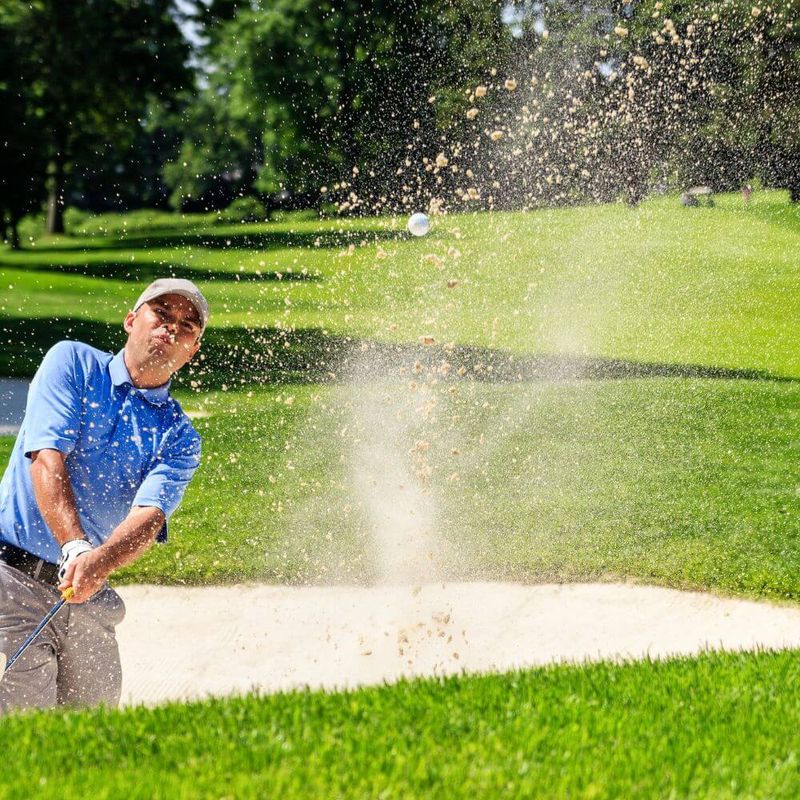Content Summary
My regular foursome was down to two today so the public course we were playing added a really nice husband and wife couple to make it a foursome. It's always so much fun meeting new people on the course and getting to know each other over the next 18 holes.
On this particular day, one of the players was struggling to get out of sand traps (bunkers) so I commented on how they were just using their hands to extricate themselves out of the bunker and not using any follow thru.
When they added some body rotation it was much easier for them to get out (this just happened to be their day to find most of the bunkers on the course).
It made me think that I had yet to add a post about sand trap/bunker play so I thought this would be a good time.
Difficulties of Sand Traps
Golf courses are full of challenging obstacles and sand traps are among the most difficult. Sand traps require a golfer to have a combination of skill, finesse and patience in order to traverse them successfully.
Unfortunately, not every golfer can master this tricky greenside bunker obstacle and that’s why it’s important to understand what makes a sand trap so hard.
This article will explore some of the difficulties that come with navigating golf course sand traps and provide helpful tips for traversing them safely.
Sand traps present unique challenges because they usually consist of soft sand which can cause shots to be unpredictable due to ball spin or even swallow up clubs if they make too much contact with the ground.
Additionally, these heavy-duty bunkers often contain mounds or ridges that must be navigated around or over before reaching the green.
Playing Out of Sand Traps on Golf Courses
Somedays no matter how hard we try, we cannot seem to avoid ending up in sand traps or as others may refer to them, golf bunkers.
When this occurs golfers are often faced with the challenge of playing out of the sand traps/bunkers. These sand traps are found all around golf courses and can provide an extra challenge for players.
To help navigate these pitfalls, there are certain rules and etiquette that govern playing out of sand bunkers.
First and foremost, it is important to make sure the ball in the bunker is yours before striking it or you may be penalized two strokes.
Once you have identified your ball you should take a few practice swings outside of the sand trap so you can get a feel for the swing you want to make while in the bunker hitting your shot.
It is also important to remember that sand traps have deep sand and it is easier to make a good shot if your feet are firmly planted in the sand for stability.
When sand trap shots are taken, it is important to remember to hit slightly behind the ball and not directly at it. Hitting slightly behind the ball will cause sand to be kicked up which in turn will launch the ball out of the sand trap with less effort.
Finally, make sure that when raking after your shot is complete that all footprints inside the bunkers are carefully smoothed over again; leaving footprints and divots untouched can have serious effects on other players’ coming shots by throwing off their lie angles or trajectory while they’re swinging towards their targets.
When playing out of sand traps on a golf course, it is important to keep several things in mind. Players should always check their stance and club position so that they do not make contact with either the face or lip of the trap before striking the ball; this could lead to a penalty stroke being assessed.
With a little bit of practice and the right technique, sand bunker play can be mastered and help shave off strokes from your game. Keep these tips in mind and you'll be sand trap-free in no time!
Pre-Shot Preparation: Choose Club, Stance & Position
Having a plan before approaching the trap can make all the difference when it comes to getting out of these situations quickly and efficiently.
Here are some tips to help golfers get ready for their shot from a sand trap:
1. Choose the Proper Club
When approaching your shot, your first choice will be which club to use. Consider where you are in respect to the green while making a decision.
Use a high loft wedge if there is only a tiny amount of green between you and the hole. Pick a lower loft wedge if you have more green to deal with. Hitting more club will help you get out of a fairway bunker and closer to the pin. Just be aware of how high the lip is in front of you.
2. Set up Correctly
Ground yourself by planting your feet in the sand. This will offer you a firm foundation in addition to assisting you in getting a sense of the texture of the sand.
The next step is to play the ball with your front foot. By positioning yourself in this fashion, you can improve the ball's trajectory. Playing it forward is a solid general rule of thumb, but there may be circumstances where hitting a shot with a lower trajectory is necessary.
When the ball is in the appropriate place, you should open your stance and club face. Aiming slightly to the left and opening your club face by two to three degrees will help you achieve this. Lastly, balance your weight so that 70-80% of it is on the front leg.
3. Think Weak Grip
Another crucial component of a successful bunker shot is using the proper grip. Approach your shot with weak gripping and supple arms.
A weak grip actually relates to the release of the hinge in your wrists, not to how tightly you are holding the club. A weak grip enables the wrist hinge to release earlier. The ball travels farther and stops on the green more quickly as a result.
4. The Right Swing is Important
It's time to concentrate on your swing now that you have a solid grasp of your set up. An outside-in swing pattern with a modest wrist bend at the top of the swing is what you want to use.
The distance you want to strike the ball will have a direct impact on how far back you move the club. Your shot might be high and soft thanks to the swing pattern's contribution to the ball's loft.
5. Finish the Follow Through
Because you're not shifting your weight back and forth as you would in a normal shot, you want to pay extra attention to your follow through.
With sand shots, you will have to stay down longer and make a nice full follow through. If you decelerate or stop your swing as soon as you hit the ball, your ball won't go anywhere.
You usually want to try to hit slightly behind the ball (or a little fat), which means you will be pulling some sand with your shot. Having a strong follow-through will ensure your shot will have enough power to drive your ball out of the bunker.
6. Focus on the Right Mindset
The strongest tool you have in golf, as many other well-known players have said, is your mental game. Your game will suffer if you approach your shot with uncertainty and annoyance.
Take your shots with assurance. Before you swing, visualize where you want the ball to go and try to block out any unfavorable ideas. There will always be a few terrible pictures, so give yourself permission to move on and take each shot with a fresh perspective.
7. Practice and Then Practice Some More!
The most useful practice is regular practice. Preparing oneself correctly is preferable to trying to completely avoid bunkers, as was previously indicated.
It's unavoidable to hit into the sand, and consistent practice will boost your self-assurance as you take on these challenging strokes.
Work on your approach to each shot as you practice. When the pressure is on later, having the ability to mentally and physically prepare can help.
Technique for In/Out of Sand Traps: Smother Shot, Explosion Shot
You already know how difficult sand traps can be to navigate. The two best ways to get out of this tricky situation are the bunker shots called smother shot and the explosion shot.
Both techniques require skill and practice, but when mastered, can help golfers save valuable strokes and get back on track with their game.
The smother shot is a low-trajectory shot that helps keep the ball close to the ground while still giving it enough power to reach its destination.
This technique requires some finesse but can be achieved by using an open stance and opening up your club face slightly as you hit through impact.
The goal is for the bottom of your club head to make contact with the sand first before launching into your ball for maximum control.
The explosion shot is completely opposite from the smother in terms of trajectory. The explosion shot is the highest of the two shots and is used to get the ball up in the air quickly.
The club face should be closed slightly at impact, allowing for a downward trajectory that will allow your ball to fly farther.
Both of these shots are great for you to have in your bag. The smother shot is great for a short approach shot, while the explosion shot is ideal for longer approaches and even shots from the rough.
The above are our thoughts on sand trap/bunker play. For a visual, I've included a video I think really helps.
Some History - Where does the term "bunker" originate from?
The term "bunker" came from military use during World War I when gun emplacements were dug into sand dunes and filled with concrete blocks or logs to protect soldiers from enemy fire.
These trenches were soon adapted by golf course architects who used them on the fairways, on a grassy hill or greens and tees as obstacles for golfers to overcome.
The term "sand trap" is self explanatory.
Conclusion: Overcome Your Fear of Sand Traps
Overcoming your fear of sand traps is an important skill for any golfer to master. With the right mindset, understanding of golf course design, and practice, you can confidently navigate any sand trap that comes your way on the green – and even score better than before.
The key to overcoming your fear of sand traps lies in recognizing that they are a natural part of the game. You may be surprised by how much control you have when you understand how to properly read a bunker and plan out each shot accordingly.
Taking a few practice swings with different clubs will help familiarize yourself with the terrain and give you confidence in making successful shots.
Also, it's important to focus on avoiding just “getting out” but instead aiming for higher quality shots that will leave you closer to the hole.
But most of all, don't rush. Focus on one thing at a time, and remember the basics of your swing: get your alignment correct, make sure you have some weight on the front foot, and hit down on the ball.
Thank you for visiting, and we hope to see you back soon!








